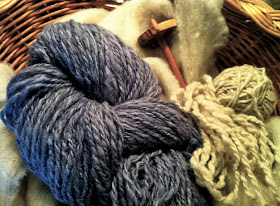Now that I've gotten the hang of
spinning yarn, I've moved onto the next project: dyeing yarn! I was going to begin my experiments with synthetic dyes, but then I learned about natural dyes and got excited about that instead.
This blog provided some great ideas and tutorials.
Here's the final product! The colors are more beautiful and rich in real life. I'm so pleased with how it turned out!
At first, I thought about starting to collect onion skins in the kitchen and just dyeing my yarn when I got enough. But then I remembered that I'm an impatient person. Instead, I went to Safeway and gathered all the loose onion skins from the onions in the produce section and tried to pretend I wasn't doing something strange. This surprisingly yielded enough for a batch! Yay for instant gratification!
Something to know about dyeing is that if you want the dye to stay in the fiber permanently you need a mordant. It's easy and cheap to make a basic mordant.
These are the instructions I used. All you need are two ingredients: Alum and Cream of Tartar; both of which can be found in the grocery store spice section. This makes an
alum mordant.
Onion skin dyeing is unusual in that it does not require a mordant. However, mordants can do a lot to change the way the color comes out. To experiment with this, I used alum mordant on my main skein, and then I did a little sample on the side without any mordant. In the top photo, the larger middle skein is with the alum mordant treated yarn, the smaller more brownish yarn on the right is without any mordant. The yarn on the left is the original color of the fiber.
Here was my yarn dyeing process:
Step 1: Make yarn into a loose skein, and tie yarn in several places to prevent tangling during the dyeing process.
Step 2: Heat up the fiber. Fill pot with water, place fiber in the water, and slowly heat it to a light simmer. (I used a thermometer the first time just to get an intuition about it. I heated it to around 80-90 degrees.
Step 3: Carefully remove fiber. Mix 1/2 tsp alum and 1/4 tsp cream of tartar into water. Return fiber to mordant bath and simmer for an hour.
Step 4: While yarn is in the mordant bath, prepare the dye. Throw all the onion skins into a pot, add some water, and boil the onion skins for around half an hour or until the water seems saturated with color.
Step 5: Drain mordant bath, and gently move the yarn from the mordant bath into the dye bath. I left the onion skins in, and I think that this gave the color a little bit of variegation and character.
Step 6: Simmer yarn in dye bath for around half an hour. Perhaps if left in the bath overnight to cool or simmered for longer the color would have come out darker. I don't know, I'm still an amateur.
Step 7: Pour pot of yarn and dye into a clean sink. Gently rinse the yarn in hot water. (Temperature shock can cause the yarn to felt. This is bad!)
Step 8: I used a salad spinner to get the yarn semi-dry. Then I hung it up over the sink to dry overnight.
Step 9: Show everyone, admire the colors, photograph, and start a project!
Stay tuned for black bean dye next! :)





















































